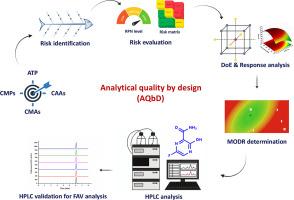Development and validation of a novel isocratic RP-HPLC method using AQbD approach for the quantification of favipiravir
IF 4.7
3区 医学
Q1 PHARMACOLOGY & PHARMACY
引用次数: 0
Abstract
Background/Objectives
In this study, the analytical quality by design (AQbD) approach was used to develop an eco-friendly reversed-phase high-performance liquid chromatography (RP–HPLC) method to identify and quantify favipiravir (FAV).
Methods
A risk assessment identified factors significantly impacting method performance. Three high level risk factors (X1: ratio of solvent, X2: pH of the buffer, X3: column type) were selected to study their impact on the following output responses: peak area (Y1), retention time (Y2), tailing factor (Y3) and theoretical plates count (Y4) using d-optimal experimental design. The method operable design region (MODR) and the robust set point were calculated using a Monte Carlo simulation method using the MODDE® 13 Pro software.
Results
The method was developed using an Inertsil® ODS-3 C18 column (250 mm, 4.6 mm, 5 μm, and 100 Å). The mobile phase was composed of A: acetonitrile and B: disodium hydrogen phosphate anhydrous buffer (pH 3.1, 20 mM) in a 18:82 v/v ratio, and was eluted at an isocratic-flow-rate of 1 mL/min at 30 °C with DAD detection at 323 nm. The method was validated as per the USP and ICH guidelines. The system suitability test parameters were within the USP limits. The method showed excellent linearity, sensitivity and selectivity. The optimized method showed good precision, accuracy and robustness with RSD value 〈 2 %. Additionally, the developed RP-HPLC method based AQbD approach showed excellent Analytical Eco-Scale score 〉 75, and was successfully applied for quantify FAV in the laboratory- prepared tablets.
Conclusions
AQbD is a useful tool to replace existing traditional methods for the optimization of a green, validated RP-HPLC method, for the routine analysis and quality control of FAV.

采用AQbD法定量Favipiravir的新型等密度反相高效液相色谱方法的建立与验证。
背景/目的:本研究采用设计质量法(AQbD)建立了一种环保的反相高效液相色谱(RP-HPLC)方法,对FAV(法匹拉韦)进行鉴定和定量。方法:风险评估确定了影响方法性能的重要因素。选取3个高危险因素(X1:溶剂比、X2:缓冲液pH、X3:柱型),采用d -最优实验设计,研究其对峰面积(Y1)、保留时间(Y2)、尾砂因子(Y3)和理论板数(Y4)输出响应的影响。方法可操作设计区域(MODR)和鲁棒设定点采用蒙特卡罗模拟方法,使用MODDE®13 Pro软件计算。结果:该方法采用Inertsil®ODS-3 C18色谱柱(250 mm, 4.6 mm, 5 μm, 100 Å)。流动相为A:乙腈和B:磷酸氢二钠无水缓冲液(pH 3.1, 20 mM),比例为18:82 v/v,以1 mL/min的等压流速在30℃下洗脱,DAD检测波长为323 nm。该方法按照USP和ICH指南进行了验证。系统适用性试验参数在USP限定范围内。该方法具有良好的线性、灵敏度和选择性。优化后的方法精密度、准确度和鲁棒性均较好,RSD值< 2%。基于AQbD的RP-HPLC方法具有良好的分析生态量表评分bbbb75,可成功用于实验室制剂中FAV的定量分析。结论:AQbD可替代现有的传统方法,为FAV的常规分析和质量控制提供一种绿色、有效的RP-HPLC方法。
本文章由计算机程序翻译,如有差异,请以英文原文为准。
求助全文
约1分钟内获得全文
求助全文
来源期刊
CiteScore
9.60
自引率
2.20%
发文量
248
审稿时长
50 days
期刊介绍:
The journal publishes research articles, review articles and scientific commentaries on all aspects of the pharmaceutical sciences with emphasis on conceptual novelty and scientific quality. The Editors welcome articles in this multidisciplinary field, with a focus on topics relevant for drug discovery and development.
More specifically, the Journal publishes reports on medicinal chemistry, pharmacology, drug absorption and metabolism, pharmacokinetics and pharmacodynamics, pharmaceutical and biomedical analysis, drug delivery (including gene delivery), drug targeting, pharmaceutical technology, pharmaceutical biotechnology and clinical drug evaluation. The journal will typically not give priority to manuscripts focusing primarily on organic synthesis, natural products, adaptation of analytical approaches, or discussions pertaining to drug policy making.
Scientific commentaries and review articles are generally by invitation only or by consent of the Editors. Proceedings of scientific meetings may be published as special issues or supplements to the Journal.

 求助内容:
求助内容: 应助结果提醒方式:
应助结果提醒方式:


